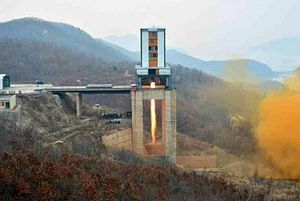In the preceding week, U.S. intelligence agencies have assessed that North Korea has started to dismantle a rocket engine test stand at the Sohae Satellite Launching Station, on the country’s west coast, The Diplomat has learned from U.S. government sources with knowledge of the latest intelligence on North Korea’s ballistic missile program.
The recent intelligence assessment is consistent with a finding first released Tuesday by 38North open source satellite imagery analyst Joe Bermudez, who also published images showing the dismantlement activity at the site.
The liquid propellant engine test stand at Sohae has been used by North Korea to conduct multiple rocket engine tests, including at least two tests of the engines that ended up powering the first stage of its two flight-tested intercontinental-range ballistic missiles, the Hwasong-14 and the Hwasong-15. (The Hwasong-15 engine was not tested there in its flight-tested configuration, however.)
Last week’s assessment also stated that the stand “can be reconstituted within months,” a U.S. government source told The Diplomat, underlining that, for now, the changes North Korea had made would be reversible.
“The engine test stand tear down does not severely impact North Korea’s liquid fuel engine development,” the source added, highlighting that the facility was no longer critical for the mass production of ballistic missiles in North Korea.
As Bermudez’s imagery shows, North Korea has dismantled the metal superstructure at the test stand, but not the concrete foundation on which the testing apparatus rests. Destroying the concrete foundation could increase the length of time required to reconstitute the site.
Dismantling the engine test stand could never truly be “irreversible,” given that North Korea can always constitute these stands at other sites or even at Sohae.
As The Diplomat had first reported, U.S. military intelligence has similarly concluded in May that North Korea’s dismantlement of the tunnel network at the Punggye-ri nuclear test site with explosives was also reversible in a matter of “weeks to months.”
Earlier this year, North Korean leader Kim Jong Un had directed the country’s munitions industry to mass produce ballistic missiles and nuclear warheads.
While the dismantlement activity at Sohae is a confidence-building measure, it is unverified and does not cap North Korea’s production of additional missiles.
On Wednesday, U.S. Secretary of State Mike Pompeo, speaking at a press conference alongside U.S. Secretary of Defense Jim Mattis, Australian Defense Minister Marise Payne, and Australian Foreign Secretary Julie Bishop, underlined that the United States had sought to verify North Korea’s dismantlement of the site.
“We’ve been pressing for there to be inspectors on the ground when that engine test facility is dismantled consistent with Chairman Kim’s commitment,” Pompeo, who was in North Korea earlier this month, said.
The dismantlement of the test stand would “be entirely consistent with the commitment that Chairman Kim made to [U.S. President Donald Trump] when the two of them were in Singapore together,” Pompeo said.
“He made that commitment to them orally,” Pompeo underlined, highlighting that the promise from Kim to dismantle the Sohae test stand was not included in the joint declaration signed by him and President Trump.
Apart from its dismantlement of the engine test stand at Sohae, North Korea has also partially disassembled a staging building for its space launch vehicles.
As far is publicly known, that was not a concession to arise out of either the Singapore summit or the subsequent round of U.S.-North Korea talks in Pyongyang.
Pompeo has recently stated that the United States continues to seek the “final, fully verified denuclearization of North Korea.”
The joint statement Kim and Trump signed in Singapore commits North Korea to work “toward the complete denuclearization of the Korean Peninsula.”

































